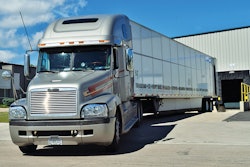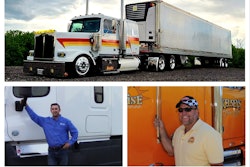PARTNERS IN BUSINESS TABLE OF CONTENTS »
Keep your No. 2 variable expense to a minimum with smart spec’ing
Just as a truck with improperly geared rears will incur extra costs for its owner, so, too, will a truck with the wrong tires. Many more factors than size account for having the right tire for a specific truck in a specific application.
A tire dealer can make recommendations based on vehicle usage and tire characteristics such as price, fuel economy, durability, traction, miles to removal, retreadability and tread depth and pattern.
All play a role in proper spec’ing, and smart spec’ing can save money in two ways: reducing tire cost per mile and fuel cost per mile. Attributes that reduce one cost can have the opposite effect on the other cost, so tread carefully. That’s easier said than done at a time when specialization abounds.
Tire makers have moved in recent years toward products that are designed to meet specific service needs. Since longer tire life means lower costs, the effort put into careful spec’ing will pay off well. The four main tire applications are long haul, regional, on/off-road and urban. The different applications mean different tire lives, from as little as 20,000 miles for urban to more than 200,000 miles for a long-haul team.

If you’re spec’ing a new truck, you can pick any tire size suitable to your application. A new truck’s drivetrain and engine controls are set according to the spec’d tire size. Replacement tires, however, may require drivetrain and engine adjustments. Changing tire sizes also might cause clearance issues.
More isn’t always better. Rather than last longer, tires with deeper tread might wear faster, burn more fuel and make driving harder if they’re applied wrongly. And the traditional miles-until-removal measure of tire performance more often now plays second fiddle in long haul to picking tires based on fuel economy.
Some regional fleets are going to long-haul steers for low rolling resistance rather than tires with more scrub resistance designed for regional operation. The tires may wear faster, but they save enough in fuel to more than cover the extra tire replacement costs.
Consider this common tractor-only scenario: The steers have a 125 rolling-resistance rating, the drives are at 137, and the truck gets 6 mpg. Replacing steers and drives with the lowest possible alternatives for RR rating (97 and 86) improves fuel economy to 6.52 mpg.
While shallower tread depth equates to better fuel economy, it also usually means shorter tire life. The good news is tire manufacturers are using technology to counter this inherent tradeoff, using different compounding and silicate makeups to help enhance life.
Practice good habits for long tire life
PERFORM ROUTINE MAINTENANCE. If a technician can initiate by hand even the slightest irregular movements in tie rod ends, kingpins, wheel bearings and torque rods, that spells trouble.
The plungers inside shock absorbers create friction, and friction creates heat, so if the shock, not the outer dust barrel covering the top half of the shock, is hot to the touch after driving, it’s working. If it’s cool to the touch, it’s not working and should be replaced. Make sure bushings at the top and bottom of shocks are inspected and replaced whenever worn. If you can grab the shock absorber and rattle it, the bushings have pounded themselves out.
Shocks should be checked every maintenance service cycle and replaced in pairs if there’s any sign of leaking fluid.
MAINTAIN PROPER INFLATION. Ironically, maintaining correct inflation is free and relatively easy, yet it’s the highest-saving maintenance you can perform on your truck. Improper inflation is by far the greatest reason why tires fail or wear out prematurely, also wasting fuel. Daily pre- and post-trip inspections give owner-operators the opportunity to check pressures and also look for leaks, punctures, broken valve stems or embedded objects such as nails. Even absent damage, truck tires typically lose one to two pounds of pressure monthly from normal use. A slow leak might cost you one to three pounds of air a day. For each pound of pressure lost, a tire’s on-road temperature rises about 2 degrees, and hot tires are prone to losing tread more quickly and failing. Don’t overinflate, either; an overinflated tire sustains rapid and irregular wear and is more susceptible to damage from running over debris and scrubbing curbs.
Underinflated tires build up excessive heat, which can damage the tire and shorten its life. Inflation also affects performance, fuel economy and maintenance costs.
A Michelin study shows that a 15 percent over- or underinflation can reduce a tire’s lifespan by 10 percent. Research from the American Trucking Associations’ Technology & Maintenance Council has shown underinflation by just 10 percent — less than 11 psi on a 105-psi tire — can result in a fuel economy drop of 1.5 percent.
EMPLOY GOOD DRIVING HABITS. One element of tire wear you have complete control over is how the truck is driven under less-than-ideal conditions. More conservative driving over rough surfaces helps reduce wear.
Speeding, hard braking, curbing and tight turns cause tires to wear faster or even develop irregular wear. On the other hand, steady acceleration, braking and steering can extend tire life. Many of the problems caused by bad driving habits show up as uneven tire wear. If you notice unusual shimmying or repetitive bumps, inspect your tires. Even absent rough driving, look for irregular tread wear in your daily pre- and post-trip inspections.
FIGHT IRREGULAR WEAR. Check axles and suspension components (bushings, tie rod ends, kingpins, shocks, etc.), replacing any that show excessive wear. On the steer axle, change your shocks at least as often as you change your tires. On the drive axle, get more aggressive, replacing shocks halfway through the tire’s life and when the tires are changed.
DOUBLE DOWN ON ALIGNMENT. Many people believe they should get new tires installed before they have a truck aligned. The opposite is true — take your truck to the alignment shop with the old tires on. That way, technicians can read your tire wear to learn what is wrong with the alignment and determine more precisely how to make adjustments that solve the problems. Also make sure your bearings are adjusted properly in all positions, and check for proper mounting — a simple inspection. Look for a ring molded into the tire where the rim and tire meet. Measure the distance from the rim to that line at four points around the tire; each measurement should be within 2/32-inch. If the variance is greater, the assembly needs to be broken down and remounted properly.
Mounting should be followed with a check of the radial run-out (deviation of the tire from a perfect circle) and lateral run-out (deviation of the sidewall from a perfect plane). Both measure how well the wheel assembly is mounted on the hub. Good quality run-out gauges cost less than $100.
Download the entire Partners in Business Manual
Chapter 1: Becoming your own boss
Chapter 2: Bookkeeping and business analysis
Chapter 3: Understanding your revenue and costs
Chapter 5: Controlling fuel costs
Chapter 6: Controlling tire costs
Chapter 8: Income tax and other taxes
Chapter 9: Choosing a business structure
Chapter 10: Truck buying, leasing, financing
Chapter 11: Choosing a trailer
Chapter 12: Maintaining your equipment
Chapter 13: Choosing a carrier
Chapter 14: Computers, mobile devices and the internet
Chapter 15: Staying compliant and safe
Chapter 16: Trucking insurance









